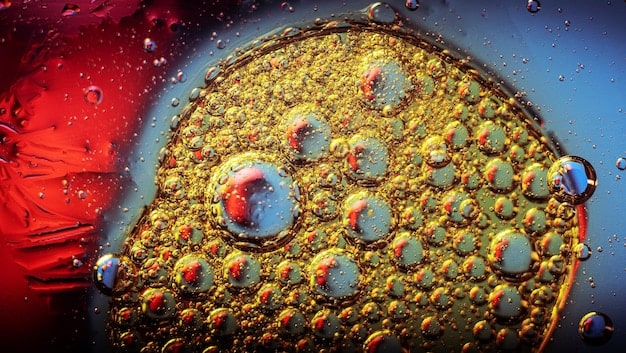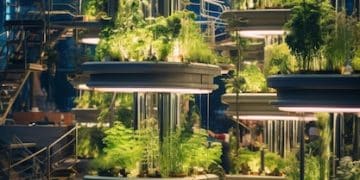Cultured Meat: Can Lab-Grown Meat Replace 20% of Traditional Meat by 2030?

Cultured meat, also known as lab-grown meat, is emerging as a sustainable and ethical alternative to traditional meat production, with the potential to significantly disrupt the food industry and potentially replace up to 20% of conventional meat consumption by 2030.
Imagine a future where the future of food: will cultured meat replace 20% of traditional meat consumption by 2030?, is no longer a question of “if,” but “how soon?”. This isn’t science fiction; it’s a rapidly developing reality. Will it truly revolutionize our plates and planet? Let’s explore.
The Rise of Cultured Meat: A New Era in Food Production
Cultured meat, also known as lab-grown or cultivated meat, represents a groundbreaking approach to food production. Instead of raising and slaughtering animals, cultured meat is produced by cultivating animal cells in a laboratory setting. This process has the potential to revolutionize the meat industry, offering a more sustainable and ethical alternative to traditional methods.
The development of cultured meat is driven by the increasing demand for meat worldwide, coupled with growing concerns about the environmental impact and ethical implications of traditional livestock farming. Cultured meat aims to address these challenges by providing a resource-efficient and cruelty-free way to produce meat.

The Science Behind Cultured Meat
The process of creating cultured meat involves several key steps. It begins with obtaining a small sample of animal cells, typically muscle cells. These cells are then placed in a nutrient-rich culture medium that provides the necessary building blocks for growth and proliferation. The cells are grown in bioreactors, which are specialized vessels that provide a controlled environment for cell cultivation.
As the cells multiply, they differentiate and form muscle tissue, replicating the texture and composition of traditional meat. The resulting cultured meat can then be harvested and processed into various meat products, such as burgers, sausages, and nuggets.
- Cell sourcing and selection
- Culture medium optimization
- Bioreactor design and operation
- Tissue engineering and scaffolding
The potential benefits of cultured meat are vast. It could significantly reduce greenhouse gas emissions, land use, and water consumption associated with traditional livestock farming. Additionally, cultured meat could eliminate the need for antibiotics in animal agriculture, reducing the risk of antibiotic resistance. From an ethical standpoint, cultured meat offers the possibility of producing meat without harming animals.
In conclusion, the rise of cultured meat signifies a paradigm shift in food production, offering a sustainable and ethical solution to meet the growing global demand for meat. While challenges remain in scaling up production and achieving cost parity with traditional meat, the potential benefits of cultured meat are undeniable.
Environmental Impact: A Sustainable Alternative
One of the most compelling arguments for cultured meat is its potential to significantly reduce the environmental impact of meat production. Traditional livestock farming is a major contributor to greenhouse gas emissions, deforestation, and water pollution. Cultured meat offers a cleaner and more sustainable alternative.
Studies have shown that cultured meat production could reduce greenhouse gas emissions by up to 96% compared to conventional beef production. It also requires significantly less land and water, making it a more resource-efficient option.
Reducing Greenhouse Gas Emissions
Livestock farming is a major source of greenhouse gases, including methane and nitrous oxide, which have a much higher global warming potential than carbon dioxide. Cultured meat production, on the other hand, generates far fewer emissions, as it eliminates the need for raising and feeding large numbers of animals.
By transitioning to cultured meat, we could significantly reduce our carbon footprint and mitigate the effects of climate change.
Conserving Land and Water Resources
Traditional livestock farming requires vast amounts of land for grazing and growing animal feed. Deforestation to create pastureland is a major driver of biodiversity loss. Cultured meat production requires only a fraction of the land needed for traditional farming, freeing up land for other uses, such as reforestation and conservation.
Similarly, cultured meat production uses significantly less water than traditional livestock farming. Water is a precious resource, and reducing water consumption is crucial for ensuring food security in the face of climate change.
- Lower greenhouse gas emissions
- Reduced land use
- Decreased water consumption
- Elimination of manure runoff and pollution
Cultured meat has the potential to revolutionize the way we produce food, making it more environmentally sustainable and resilient. While challenges remain in scaling up production and reducing costs, the environmental benefits of cultured meat are undeniable.
In summary, the environmental advantages of cultured meat are substantial, offering a pathway to a more sustainable and eco-friendly food system.
Consumer Acceptance: Overcoming the “Yuck Factor”
Despite the potential benefits of cultured meat, consumer acceptance remains a significant hurdle. Many consumers are hesitant about the idea of eating meat grown in a laboratory, often citing concerns about safety, taste, and naturalness.
Overcoming the “yuck factor” will be crucial for the widespread adoption of cultured meat. This will require clear and transparent communication about the production process, as well as addressing consumer concerns about safety and nutrition.
Addressing Safety Concerns
One of the main concerns consumers have about cultured meat is its safety. Some worry about the potential for contamination or the use of harmful chemicals in the production process. However, cultured meat is subject to rigorous safety testing and regulation, just like traditional meat.
Regulatory agencies, such as the FDA and USDA, are working to establish clear guidelines for the production and labeling of cultured meat to ensure its safety and quality.
Improving Taste and Texture
Another challenge is replicating the taste and texture of traditional meat. Early versions of cultured meat have been criticized for lacking the rich flavor and satisfying chewiness of conventional meat. However, significant progress has been made in recent years in improving the taste and texture of cultured meat.
Researchers are experimenting with different cell types, culture mediums, and scaffolding techniques to create cultured meat products that closely resemble traditional meat in terms of taste and texture.

- Transparent communication about the production process
- Addressing safety concerns through rigorous testing and regulation
- Improving taste and texture through research and innovation
- Educating consumers about the benefits of cultured meat
Consumer acceptance of cultured meat will depend on building trust and confidence in the product. This will require a concerted effort by researchers, regulators, and industry stakeholders to address consumer concerns and communicate the benefits of cultured meat in a clear and compelling way.
In conclusion, overcoming the “yuck factor” is essential for the widespread adoption of cultured meat, and this will require addressing consumer concerns about safety, taste, and naturalness.
Regulatory Landscape: Paving the Way for Cultured Meat
The regulatory landscape for cultured meat is still evolving, but progress is being made in establishing clear guidelines for its production and labeling. Regulatory agencies in the United States, Europe, and other countries are working to develop frameworks that ensure the safety and quality of cultured meat while fostering innovation in the industry.
Collaboration between regulatory agencies, industry stakeholders, and consumer groups is essential for creating a regulatory environment that promotes the responsible development and commercialization of cultured meat.
FDA and USDA Collaboration
In the United States, the FDA and USDA have agreed to jointly oversee the regulation of cultured meat. The FDA is responsible for overseeing the cell culture and pre-market safety evaluation, while the USDA is responsible for inspecting production facilities and regulating labeling.
This collaborative approach aims to ensure that cultured meat products are safe, wholesome, and accurately labeled.
Labeling Requirements
Labeling requirements for cultured meat are still under development, but they are likely to include information about the product’s ingredients, nutritional content, and production method. Clear and accurate labeling is essential for helping consumers make informed choices about the food they eat.
Some consumer groups have advocated for mandatory labeling of cultured meat, while industry stakeholders have argued for flexibility in labeling to avoid stigmatizing the product.
- Clear and transparent regulations
- Collaboration between regulatory agencies and industry stakeholders
- Accurate and informative labeling
- Consumer education about cultured meat
The regulatory landscape for cultured meat will play a crucial role in shaping the future of the industry. A well-defined regulatory framework can foster innovation, build consumer trust, and ensure the safety and quality of cultured meat products.
In summary, the regulatory landscape is a critical factor in paving the way for the successful commercialization of cultured meat, requiring collaboration and clear guidelines to ensure safety and consumer confidence.
Economic Viability: Can Cultured Meat Compete on Price?
One of the biggest challenges facing the cultured meat industry is achieving cost parity with traditional meat. Currently, cultured meat is significantly more expensive to produce than conventional meat, making it difficult to compete on price. However, significant progress is being made in reducing the cost of cultured meat production, and experts believe that it could become economically viable in the coming years.
Factors that will influence the economic viability of cultured meat include the cost of cell culture mediums, the efficiency of bioreactors, and the scale of production.
Reducing the Cost of Cell Culture Mediums
Cell culture mediums are a major cost driver in cultured meat production. These mediums contain the nutrients and growth factors that cells need to proliferate and differentiate. Traditionally, cell culture mediums have been very expensive, but researchers are working to develop cheaper and more sustainable alternatives.
One approach is to use plant-based or microbial-based ingredients instead of animal-derived ingredients. Another approach is to recycle and reuse cell culture mediums.
Improving Bioreactor Efficiency
Bioreactors are specialized vessels used to grow cells in a controlled environment. Improving the efficiency of bioreactors can significantly reduce the cost of cultured meat production. Researchers are working to optimize bioreactor design and operation to maximize cell growth and minimize energy consumption.
Innovations in bioreactor technology, such as continuous perfusion systems and three-dimensional scaffolding, are helping to increase cell density and productivity.
- Reducing the cost of cell culture mediums
- Improving bioreactor efficiency
- Scaling up production
- Optimizing the supply chain
The economic viability of cultured meat will depend on continued innovation and investment in research and development. As production costs come down, cultured meat will become more accessible to consumers and more competitive with traditional meat.
In closing, achieving economic viability is crucial for cultured meat to become a mainstream alternative, requiring focus on reducing production costs and scaling operations.
Future Projections: Will Cultured Meat Replace 20% of Traditional Meat Consumption by 2030?
The question of whether cultured meat will replace 20% of traditional meat consumption by 2030 is a subject of much debate. While the industry faces significant challenges, it also has enormous potential. Some analysts predict that cultured meat could capture a significant share of the meat market in the coming years, while others are more cautious.
Several factors will influence the future adoption of cultured meat, including consumer acceptance, regulatory approval, and economic viability.
Factors Influencing Adoption
Consumer acceptance is perhaps the most critical factor. If consumers are unwilling to eat cultured meat, it will never become a mainstream product. Regulatory approval is also essential. Cultured meat must be approved by regulatory agencies before it can be sold to consumers. Economic viability is another important factor. Cultured meat must be competitively priced with traditional meat in order to attract consumers.
Technological advancements, such as improved cell lines and more efficient bioreactors, will also play a crucial role in the future of cultured meat.
Potential Impact on the Meat Industry
If cultured meat does capture a significant share of the meat market, it could have a profound impact on the traditional meat industry. Livestock farming could become less intensive, and land used for grazing could be repurposed for other uses. The environmental impact of meat production could be greatly reduced.
The rise of cultured meat could also create new economic opportunities in areas such as cell culture technology, bioreactor manufacturing, and food processing.
- Consumer acceptance
- Regulatory approval
- Economic viability
- Technological advancements
The future of cultured meat is uncertain, but the potential benefits are too great to ignore. With continued innovation and investment, cultured meat could play a significant role in feeding the world in a sustainable and ethical way.
In conclusion, the future of cultured meat hinges on several factors, but the potential to replace a significant portion of traditional meat consumption by 2030 is within reach if challenges are addressed effectively.
| Key Point | Brief Description |
|---|---|
| 🌱 Environmental Impact | Cultured meat reduces greenhouse gases, land, and water use. |
| 🤔 Consumer Acceptance | Overcoming concerns about safety, taste, and “naturalness” is crucial. |
| ⚖️ Regulatory Landscape | Clear regulations are needed to ensure safety and foster innovation. |
| 💰 Economic Viability | Reducing production costs is essential for competing with traditional meat. |
FAQ
▼
Cultured meat, also known as lab-grown meat, is produced by cultivating animal cells in a controlled environment, offering a potential alternative to traditional meat production.
▼
Yes, cultured meat undergoes rigorous safety testing and regulation to ensure it is safe for consumption, similar to traditional meat products.
▼
Cultured meat significantly reduces environmental impact, including lower greenhouse gas emissions, reduced land use, and decreased water consumption compared to traditional livestock farming.
▼
The main challenges for cultured meat include consumer acceptance, regulatory approval, achieving cost parity with traditional meat, and scaling up production.
▼
While timelines vary, many experts predict that cultured meat will become more widely available in the coming years as production costs decrease and regulatory approvals are granted.
Conclusion
The journey towards widespread adoption of cultured meat is filled with both promise and challenges. While it’s difficult to definitively say if cultured meat will replace 20% of traditional meat consumption by 2030, the potential benefits for the environment, animal welfare, and food security make it a field worth watching closely. Continued research, investment, and open dialogue with consumers will be crucial in shaping the future of food.





